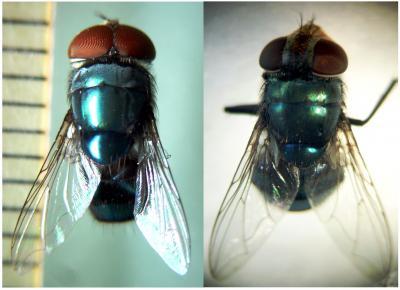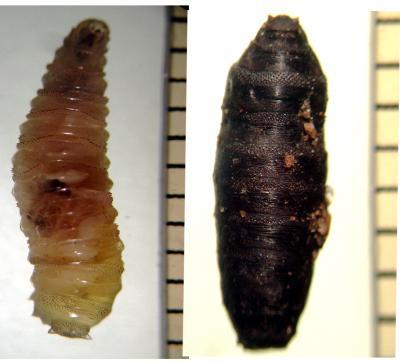This dipteran fly, therefore, serves as a potential vector of many diseases due to its close association with human dwellings. In general, C. megacephala is considered important in medical, veterinary and forensic sciences. Post mortem interval (PMI) determination is useful in cases of homicide, suicide and accidental or unattended death because of natural causes. An important aspect of calculating the PMI is the accurate and quick identification of the dipteran fly collected from a crime scene.
Behaviour and developmental times of dipteran flies are essential in determining the PMI. Currently, the most common way is to identify dipteran flies for examining the adult stage under a compound microscope. It requires that the larvae collected from a crime scene should be reared until development is complete. The dipteran fly can be identified in the larval form, but if the critical characteristics are small or vary ever so slightly, misidentification is possible.

This image depicts Chrysomya megacephala larvae on decomposing fish.
(Photo Credit: Mr. P. Ramaraj)
Morphological identification is difficult within the dipteran flies. A more precise method is to identify the dipteran flies genetically by encoding the collected DNA sequence at mitochondrial cytochrome oxidase gene subunit I (mtCOI). Presently, three forms of C. megacephala are recognized, namely, the normal form (nf), the synanthropic derived form (sdf) and the recently reported feral derived form (fdf).
The normal form is confined to forests of South Pacific Islands while synanthropic derived form has spread around the world from Papua New Guinea. The recently reported feral derived form (fdf) in the forests of the Himalaya, India is morphologically intermediate between normal and synanthropic derived forms. However, the occurrence of the synanthropic derived form of C. megacephala has not been documented in the State of Tamil Nadu, India.
In this context, a report for the first time for C. megacephala (sdf) from Royapuram fishing harbour, Chennai, Tamil Nadu, South East India is significant. A colony of C. megacephala was established from numerous second and third instar larvae collected from decaying fishes. The life expectancy of this fly is 40-45 days. Freshly emerged adults from pupae were identified through morphological and molecular studies.

This image depicts the male and female adult of Chrysomya megacephala.
(Photo Credit: Mr. P. Ramaraj)

This image shows the larva and pupa of Chrysomya megacephala.
(Photo Credit: Chrysomya megacephala)
Source: Pensoft Publishers